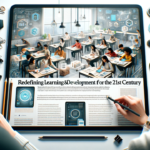In the ever-evolving landscape of the modern workplace, virtual reality (VR) emerges as a groundbreaking tool, reshaping how we perceive and engage in remote work. This innovative technology, once a figment of science fiction, now offers tangible solutions to the challenges of telecommuting. It bridges physical distances, fosters collaboration, and creates immersive experiences that transcend traditional boundaries. Let’s delve into how VR is setting a new standard for remote work, promising a future where geography is no longer a barrier to professional interactions.
Transforming Communication
The essence of VR in remote work lies in its ability to revolutionize communication. Traditional video conferencing tools have served us well, yet they fall short of replicating the nuances of in-person interactions. VR steps in to fill this gap. It enables colleagues to meet in virtual spaces, conveying body language and other non-verbal cues with remarkable fidelity. This heightened level of interaction enhances understanding and teamwork, making remote collaborations as effective as those in physical offices.
Bridging the Physical Divide
Transitioning to VR, remote teams find themselves in a shared virtual environment. This setup not only facilitates seamless communication but also fosters a sense of presence. Employees scattered across different continents can work side by side, interact with 3D models, and engage in brainstorming sessions as if they were in the same room. Such immersive experiences strengthen team bonds and boost productivity, illustrating the powerful role of VR in connecting a global workforce.
Enhancing Training and Development
Another significant advantage of VR in remote work is its impact on training and development. Traditional online training often struggles to capture the attention and interest of participants. VR, however, introduces an interactive and engaging approach to learning. Employees can participate in simulated environments that offer hands-on experience without the risks associated with real-world training. This method proves particularly beneficial for complex tasks or procedures, ensuring employees are well-prepared and confident in their roles.
Revolutionizing Skill Acquisition
Through VR, companies can offer more diverse and comprehensive training programs. Employees gain access to virtual workshops, tutorials, and courses that cater to various learning styles and preferences. This flexibility enhances skill acquisition and professional growth, demonstrating VR’s potential to tailor educational experiences to individual needs.
Overcoming Remote Work Challenges
Despite the benefits of telecommuting, remote work poses its own set of challenges, including isolation and the blurring of work-life boundaries. VR technology addresses these issues head-on, providing innovative solutions that promote well-being and work-life balance. Virtual reality spaces can mimic office environments, offering a clear separation between work and personal life. Moreover, VR social spaces allow for informal interactions among colleagues, mitigating feelings of isolation and fostering a vibrant company culture.
Creating a Balanced Remote Work Environment
The adaptability of VR enables companies to design workspaces that align with their unique culture and values. These virtual offices can be customized to include relaxation zones, collaborative spaces, and individual work areas, ensuring employees have a healthy and balanced remote work experience. This level of customization underscores VR’s potential to create a more inclusive and flexible working environment.
Looking Ahead: The Future of Remote Work with VR
As we gaze into the future, the integration of VR in remote work appears not just promising but inevitable. The technology is set to evolve, offering even more realistic and immersive experiences. This progression will likely encourage wider adoption, making VR a standard tool in the remote work toolkit. Furthermore, as VR becomes more accessible and user-friendly, its impact on remote work will only deepen, opening up new possibilities for collaboration, innovation, and productivity.
Embracing the Virtual Revolution
The journey towards fully integrating VR into remote work is underway. Companies and employees alike must embrace this technological revolution, exploring the vast potential it holds for transforming the workplace. As we adapt to this new frontier, the benefits of virtual reality in remote work will become increasingly evident, marking a significant shift in how we connect, collaborate, and create in a digital age.
In conclusion, virtual reality stands at the forefront of a monumental shift in remote work. It offers innovative solutions to longstanding challenges, from enhancing communication and collaboration to revolutionizing training and development. As we embrace this new frontier, VR promises to redefine the boundaries of the workplace, fostering a future where distance is no deterrent to professional success and connection.

